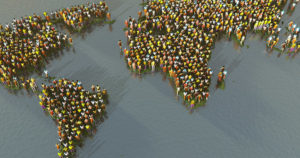Global population growing, urbanising, ageing and migrating – new report
 A new snapshot of global population trends shows that humanity is rapidly ageing as it becomes a more mobile and city-based species.
A new snapshot of global population trends shows that humanity is rapidly ageing as it becomes a more mobile and city-based species.
The world’s population reached nearly 7.6 billion in mid-2017, a rise of one billion people since 2005 and two billion since 1993.
And for the first time in history, more people live in cities than rural areas.
Every year millions of people are leaving their homes in the countryside and migrating towards urban centres both within their own countries and across borders.
Some of these people move to seek new opportunities and improve their lives but others are forced to flee due to conflict or sudden or slow onset disasters, such as drought, flooding or rising sea levels.
Rural populations, whose livelihoods depend on agricultural, are particularly vulnerable to migration pressures. They are more exposed, have high natural resource dependency and limited ability to cope with and manage risk.
In 2017, about 50.4 per cent of the world’s population was male and 49.6 per cent female, nine per cent of the global population was under age 5, 26 per cent was under age 15, 13 per cent was aged 60 or over and 2 per cent was aged 80 or over.
Current estimates indicate that roughly 83 million people are being added to the world’s population every year. Even assuming that fertility levels will continue to decline, the global population is expected to reach 8.6 billion in 2030, 9.8 billion in 2050 and 11.2 billion in 2100.
These are the main findings of the World Population Prospects report, recently revised with 2017 data.
The report, produced by the United Nations Department of Economic and Social Affairs, says future growth will be influenced not only by future levels of fertility, mortality, and migration but also by the current age distribution of the world’s population.
“Thanks to ‘population momentum’, a relatively youthful age distribution promotes a more rapid pace of population growth, whereas a relatively older age distribution contributes to a slower rate of growth or even population decline,” the report says.
It says that in recent years, fertility has declined in virtually all regions of the world.
A reduction in the fertility level results not only in a slower pace of population growth but also in a more aged population; for the population of the world and of many countries and regions, as the population growth rate has fallen over time, the proportion of older persons has increased while that of younger persons has decreased.
In 2017, there are more than twice as many children under the age of 15 in the world as there are older persons aged 60 or above. In 2050, however, the number of persons aged 60 or above will be roughly equal to the number of children under the age of 15, with about 2.1 billion in each group, the report says.
It says ten countries are expected to account collectively for more than half of the world’s projected population increase over the period 2017-2050: India, Nigeria, the Democratic Republic of Congo, Pakistan, Ethiopia, the United Republic of Tanzania, the United States of America, Uganda, Indonesia and Egypt.
The report says that substantial improvements in life expectancy have occurred in recent years.
Globally, life expectancy at birth has risen from 65 years for men and 69 years for women in 2000-2005 to 69 years for men and 73 years for women in 2010-2015.
However, large disparities between countries remain. At one extreme, countries or areas with a life expectancy of 82 years or more for both sexes combined include Australia, Hong Kong SAR (China), Iceland, Italy, Japan, Macao SAR (China), Singapore, Spain and Switzerland.
At the other extreme, countries with a life expectancy below 55 years include the Central African Republic, Chad, Côte d’Ivoire, Lesotho, Nigeria, Sierra Leone, Somalia and Swaziland.
Globally, life expectancy for both sexes combined is projected to rise from 71 years in 2010-2015 to 77 years in 2045-2050 and eventually to 83 years in 2095-2100, the report says.
It says there continues to be large movements of migrants between regions, often from low – and middle – income countries toward high-income countries.
The volume of the net inflow of migrants to high-income countries in 2010-2015 (3.2 million per year) represented a decline from a peak attained in 2005-2010 (4.5 million per year).
High-income countries with a net inflow of more than 100 thousand migrants per year in 2010-2015 included the United States of America, Germany, Saudi Arabia, Canada, the United Kingdom, Australia, Oman, Kuwait and Qatar.
Among upper-middle-income countries, excluding those experiencing a large influx of refugees, the Russian Federation, South Africa and Malaysia also had a net inflow of more than 100 thousand migrants per year in 2010-2015, the report says.
The countries with a net outflow of more than 100 thousand migrants per year in 2010-2015, excluding those dominated by refugee movements, were India, Bangladesh, China, Pakistan, the Philippines and Spain.
The report says the Syrian refugee crisis has had a major impact on levels and patterns of international migration in recent years, affecting several countries.
The estimated net outflow from the Syrian Arab Republic was 4.2 million persons in 2010-2015. Most of these refugees went to Syria’s neighbouring countries, contributing to an unusually large influx of migrants to Turkey (net inflow of 1.6 million over five years), Lebanon (1.25 million) and Jordan (975,000).
Laurie Nowell
AMES Australia Senior Journalist












